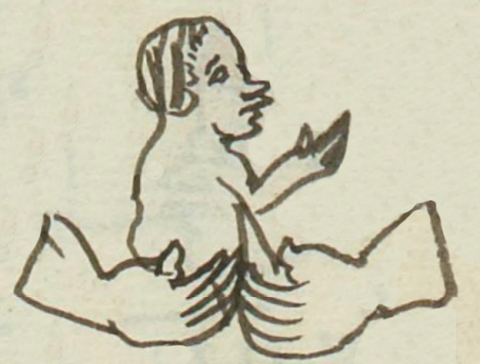Tenapalo (MH551r)
This black-line drawing of the simplex glyph for the personal name or occupation Tenapalo (“Godparent,” "He Carries People," or "Governor," attested here as a man’s name) shows two hands coming together as though to support and perhaps protect a baby that is sitting upright. The baby or small child is naked. It sits facing toward the viewer's right. Its right arm is bent with the hand reaching out.
Stephanie Wood
According to Molina (1571), the term tenapaloani refers to a governor, in the sense of someone who is responsible for others. The "godparent" translation of tenapalo, which appears to fit the visual in the glyph, must be a Spanish colonial twist on the original term. Also important for understanding this glyph is the term nepaloa (which has the added indefinite pronoun, Te-, at the front in this name). It means to carry in one's arms, which is a very tempting explanation for the visual elements of this glyph. Thus, the translation could be something more like "He Carries People." He could also be an officer of some kind in the municipality, responsible in some way for the people of the altepetl.
Stephanie Wood
pedro tenapallo
Pedro Tenapalo
Stephanie Wood
1560
Stephanie Wood
cargar, llevar, bebés, padrinos

tenapalo, godparent, https://nahuatl.wired-humanities.org/content/tenapalo
tenapaloani, governor, https://nahuatl.wired-humanities.org/content/tenapaloani
napaloa, to embrace; to adopt; take, carry in one's arms, https://nahuatl.wired-humanities.org/content/napaloa
napalhuia, to take something in one's hands, or in one's arms for another person, https://nahuatl.wired-humanities.org/content/napaloa
Padrino, o Él Que Lleva Gente en Sus Brazos
Stephanie Wood
Matrícula de Huexotzinco, folio 551r, World Digital Library, https://www.loc.gov/resource/gdcwdl.wdl_15282/?sp=181&st=image.
This manuscript is hosted by the Library of Congress and the World Digital Library; used here with the Creative Commons, “Attribution-NonCommercial-ShareAlike 3.0 License” (CC-BY-NC-SAq 3.0).




